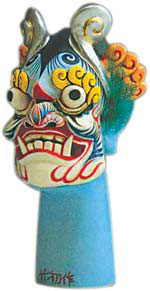There are various stories behind people's names, and the naming of Xu Zhuchu is related to Master Hongyi, an eminent Buddhist monk. It was in 1938 when the master was invited to Zhangzhou of East China's Fujian Province to teach Buddhist doctrines.
He lived in a local temple next to the home of Xu's grandfather and became a family friend. When he was asked to name the newborn baby, the master thought for a moment and suggested zhu chu, literally meaning bamboo shoot. "May the child grow up as vigorously as the bamboo shoots, and bring the family a glorious prospect," he said.
All his life, Xu Zhuchu has been living up to that wish by reviving the family art of puppet carving. His efforts have won him the national honor of the Intangible Culture Heritage (ICH) inheritor.
In China's long dynamic history of puppet art, Zhangzhou's glove puppet play enjoys great popularity in southern Fujian Province. And the unique handicraft of making puppet heads has developed into an independent genre.
It is thought that Xu's ancestors opened the first family workshop of wooden puppet head carving in the late Ming Dynasty (1368-1644). Xu's father, a veteran of both puppet and Buddhist statue carving, brought the family tradition to a new height as his Tianran workshop made a big name for itself in Fujian.
Xu began the strict discipline of puppet carving as a child. He often stayed up late to practice the craft, using all his father's timber. He focused on the work so much that he once got his hair burnt by the candle. In his teens, he won several national prizes and his talents stunned the art world in the 1950s.
Xu has created more than 600 puppet figures from Chinese operas and folktales, which display the best of his family's craft. His works appear in puppet films and have become a must for art collectors even though the puppet play is waning in popularity.
Art critics believe that instead of simply repeating his predecessors' works, Xu has recreated a lot based on his studies of the characters and plots of puppet plays.
His carving of a chou (clown) figure is a good example. He doesn't directly imitate the facial make-up of the local operas. He works hard on the facial features to make them perfectly match the character. Skinny faces, sharp-pointed jaws, narrow long eyes, bristling moustache and protruding teeth: a mouse-like human face emerges, revealing an intelligent yet cunning character.
Xu says that behind every successful puppet head are his in-depth observations and analysis of people from different walks of life. He grabs their most vivid expressions and presents them on puppets' faces.
Xu also assimilates other folk arts into his puppet carving. He has been a Chinese opera enthusiast ever since childhood and he also visits the story-telling studios and Buddhist temples where he keeps record of distinctive statues.
Xu's Zhangzhou Zhuchu Puppet Art Museum is arguably the first of its kind. Visitors can appreciate works that have toured more than 100 countries and regions, and also Xu's collection of puppet carvings by ancient masters.
(China Daily August 7, 2007)




